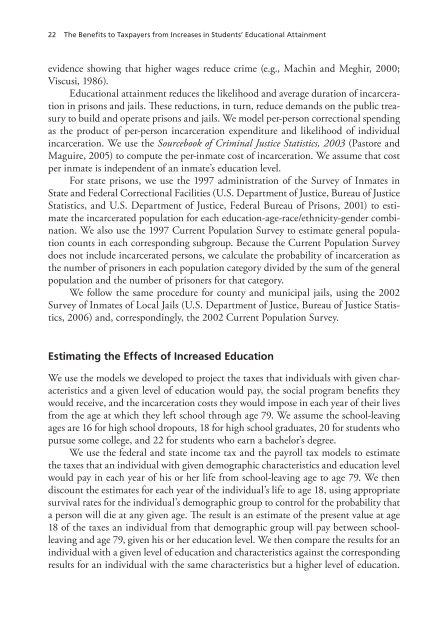The Benefits to Taxpayers from Increases in Students - RAND ...
The Benefits to Taxpayers from Increases in Students - RAND ...
The Benefits to Taxpayers from Increases in Students - RAND ...
Create successful ePaper yourself
Turn your PDF publications into a flip-book with our unique Google optimized e-Paper software.
22 <strong>The</strong> <strong>Benefits</strong> <strong>to</strong> <strong>Taxpayers</strong> <strong>from</strong> <strong>Increases</strong> <strong>in</strong> <strong>Students</strong>’ Educational Atta<strong>in</strong>ment<br />
evidence show<strong>in</strong>g that higher wages reduce crime (e.g., Mach<strong>in</strong> and Meghir, 2000;<br />
Viscusi, 1986).<br />
Educational atta<strong>in</strong>ment reduces the likelihood and average duration of <strong>in</strong>carceration<br />
<strong>in</strong> prisons and jails. <strong>The</strong>se reductions, <strong>in</strong> turn, reduce demands on the public treasury<br />
<strong>to</strong> build and operate prisons and jails. We model per-person correctional spend<strong>in</strong>g<br />
as the product of per-person <strong>in</strong>carceration expenditure and likelihood of <strong>in</strong>dividual<br />
<strong>in</strong>carceration. We use the Sourcebook of Crim<strong>in</strong>al Justice Statistics, 2003 (Pas<strong>to</strong>re and<br />
Maguire, 2005) <strong>to</strong> compute the per-<strong>in</strong>mate cost of <strong>in</strong>carceration. We assume that cost<br />
per <strong>in</strong>mate is <strong>in</strong>dependent of an <strong>in</strong>mate’s education level.<br />
For state prisons, we use the 1997 adm<strong>in</strong>istration of the Survey of Inmates <strong>in</strong><br />
State and Federal Correctional Facilities (U.S. Department of Justice, Bureau of Justice<br />
Statistics, and U.S. Department of Justice, Federal Bureau of Prisons, 2001) <strong>to</strong> estimate<br />
the <strong>in</strong>carcerated population for each education-age-race/ethnicity-gender comb<strong>in</strong>ation.<br />
We also use the 1997 Current Population Survey <strong>to</strong> estimate general population<br />
counts <strong>in</strong> each correspond<strong>in</strong>g subgroup. Because the Current Population Survey<br />
does not <strong>in</strong>clude <strong>in</strong>carcerated persons, we calculate the probability of <strong>in</strong>carceration as<br />
the number of prisoners <strong>in</strong> each population category divided by the sum of the general<br />
population and the number of prisoners for that category.<br />
We follow the same procedure for county and municipal jails, us<strong>in</strong>g the 2002<br />
Survey of Inmates of Local Jails (U.S. Department of Justice, Bureau of Justice Statistics,<br />
2006) and, correspond<strong>in</strong>gly, the 2002 Current Population Survey.<br />
Estimat<strong>in</strong>g the Effects of Increased Education<br />
We use the models we developed <strong>to</strong> project the taxes that <strong>in</strong>dividuals with given characteristics<br />
and a given level of education would pay, the social program benefits they<br />
would receive, and the <strong>in</strong>carceration costs they would impose <strong>in</strong> each year of their lives<br />
<strong>from</strong> the age at which they left school through age 79. We assume the school-leav<strong>in</strong>g<br />
ages are 16 for high school dropouts, 18 for high school graduates, 20 for students who<br />
pursue some college, and 22 for students who earn a bachelor’s degree.<br />
We use the federal and state <strong>in</strong>come tax and the payroll tax models <strong>to</strong> estimate<br />
the taxes that an <strong>in</strong>dividual with given demographic characteristics and education level<br />
would pay <strong>in</strong> each year of his or her life <strong>from</strong> school-leav<strong>in</strong>g age <strong>to</strong> age 79. We then<br />
discount the estimates for each year of the <strong>in</strong>dividual’s life <strong>to</strong> age 18, us<strong>in</strong>g appropriate<br />
survival rates for the <strong>in</strong>dividual’s demographic group <strong>to</strong> control for the probability that<br />
a person will die at any given age. <strong>The</strong> result is an estimate of the present value at age<br />
18 of the taxes an <strong>in</strong>dividual <strong>from</strong> that demographic group will pay between schoolleav<strong>in</strong>g<br />
and age 79, given his or her education level. We then compare the results for an<br />
<strong>in</strong>dividual with a given level of education and characteristics aga<strong>in</strong>st the correspond<strong>in</strong>g<br />
results for an <strong>in</strong>dividual with the same characteristics but a higher level of education.
















